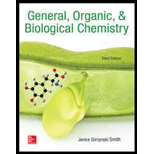
Concept explainers
(a)
Interpretation:
The reaction or process that is catalyzed by a lipase enzyme should be determined.
Concept Introduction:
The enzymes are considered as the catalyst for the biochemical reaction. They are involved in the biochemical reactions to speed them up but again regenerate at the end of the reaction or process. The Lock and Key model was purposed to explain the reactivity of enzymes. It states that each enzyme has certain active sites that can only allow the bonding of certain subtract molecules. An enzyme is very specific for the substance, pH, and temperature of the surroundings.
(b)
Interpretation:
The reaction or process that is catalyzed by a-ketoglutarate dehydrogenase enzyme should be determined.
Concept Introduction:
The enzymes are considered as the catalyst for the biochemical reaction. They are involved in the biochemical reactions to speed them up but again regenerate at the end of the reaction or process. The Lock and Key model was purposed to explain the reactivity of enzymes. It states that each enzyme has certain active sites that can only allow the bonding of certain subtract molecules. An enzyme is very specific for the substance, pH, and temperature of the surroundings.
(c)
Interpretation:
The reaction or process that is catalyzed by the amylase enzyme should be determined.
Concept Introduction:
The enzymes are considered as the catalyst for the biochemical reaction. They are involved in the biochemical reactions to speed them up but again regenerate at the end of the reaction or process. The Lock and Key model was purposed to explain the reactivity of enzymes. It states that each enzyme has certain active sites that can only allow the bonding of certain subtract molecules. An enzyme is very specific for the substance, pH, and temperature of the surroundings.
Want to see the full answer?
Check out a sample textbook solution
Chapter 23 Solutions
General, Organic, & Biological Chemistry
- The glycolysis pathway is shown. Place the enzymes used in each of the ten labeled steps of the pathway. Be sure to scroll down completely until pyruvate is formed. glucose-6-phosphate fructose-6-phosphate fructose-1,6-biphosphate ADP ATP ADP ATP glucose dihydroxyacetonephosphate glyceraldehyde-3-phosphate 1,3-bisphosphoglycerate ADP ATP 3-phosphoglycerate 2-phosphoglycerate phosphoenolpyruvate ADP ATP pyruvate Answer Bank phosphoglycerate mutase hexokinase phosphohexose isomerase triosephosphate isomerase phosphofructokinase-1 pyruvate kinase phosphoglycerate kinase aldolase enolase glyceraldehyde-3-phosphate dehydrogenase NAD + HOPO3²- NADH+H*arrow_forwardOne of the steps that occur during the synthesis of ketone bodies is shown below. OH D-beta-hydroxybutyrate Dehydrógenase .coo coo0 H3C cooo Нас acetoacetate D-beta-hydroxybutyrate Does this process require FAD or NAD*, FADH2 or NADH as the reactant coenzyme? Explain your answer in a few words.arrow_forwardThe glycolysis pathway is shown. Place the enzymes used in each of the ten labeled steps of the pathway. Be sure to scroll down completely until pyruvate is formed. triosephosphate isomerase phosphofructokinase-1 glucose-6-phosphate fructose-6-phosphate fructose-1,6-biphosphate ADP ATP ADP hexokinase ATP glucose dihydroxyacetonephosphate phosphohexose isomerase Answer Bank What am I doing wrong? aldolase glyceraldehyde-3-phosphate glyceraldehyde-3-phosphate dehydrogenase phosphoglycerate kinase phosphoglycerate mutase enolase pyruvate kinase NAD* + HOPO₂² NADH+H* 1,3-bisphosphoglycerate ADP ATP 3-phosphoglycerate Z-phosphoglycerate phosphoenolpyruvate ADP ATP pyruvatearrow_forward
- To which class does pyruvate decarboxylase, alanine aminotransferase, alcohol dehydrogenase, and hexokinase enzymes belong?arrow_forwardDefine the term oxidative deamination?arrow_forwardRefer to the following reaction. The substrate of this reaction is called through a mechanism called "Feed Forward Activation". (A) Phosphoenolpyruvate, Fructose 1,6-bisphosphate Lactate, NADH OPO₂²- ADP ATP J = 4 O H₂C H₂C 2-phosphoglycerate, AMP Glyceraldehyde 3-phosphate, ATP and the enzyme is activated by high conc. ofarrow_forward
- Identify the classification of drug metabolism and specific type of reaction involved in each drugsample. Identify the enzyme involved in each reaction.arrow_forwardConsider this chemical reaction. What chemical is the oxidizing agent? COO™ HIC-H HIC-H FAD FADH₂ COO™ succinate FADH2 succinate FAD fumarate succinate dehydrogenase COO™ H-C -H COO fumaratearrow_forwardWhat are the products of hydrolysis of maltose?arrow_forward
- Stearic acid is the common name for the C18 straight-chain, saturated fatty acid. Draw the structure of the fatty acyl-CoA that this forms (you don't have to draw out all of the atoms in coenzyme A; you can represent it as S-, and then show all of the reactions). Draw & identify all of the compounds formed when the eighteen carbon fat is converted to two molecules of acetyl-CoA and the fourteen-carbon fat via two turns of the fatty acid spiral. List the enzymes and coenzymes that are part of the pathway.arrow_forwardWhat type of specificity (absolute, group, linkage, or stereochemical) is associated with each of the following enzymes? a. Sucrase b. A lipase c. A decarboxylase d. L-glutamate oxidasearrow_forward
 General, Organic, and Biological ChemistryChemistryISBN:9781285853918Author:H. Stephen StokerPublisher:Cengage Learning
General, Organic, and Biological ChemistryChemistryISBN:9781285853918Author:H. Stephen StokerPublisher:Cengage Learning Organic And Biological ChemistryChemistryISBN:9781305081079Author:STOKER, H. Stephen (howard Stephen)Publisher:Cengage Learning,
Organic And Biological ChemistryChemistryISBN:9781305081079Author:STOKER, H. Stephen (howard Stephen)Publisher:Cengage Learning, Chemistry for Today: General, Organic, and Bioche...ChemistryISBN:9781305960060Author:Spencer L. Seager, Michael R. Slabaugh, Maren S. HansenPublisher:Cengage Learning
Chemistry for Today: General, Organic, and Bioche...ChemistryISBN:9781305960060Author:Spencer L. Seager, Michael R. Slabaugh, Maren S. HansenPublisher:Cengage Learning



